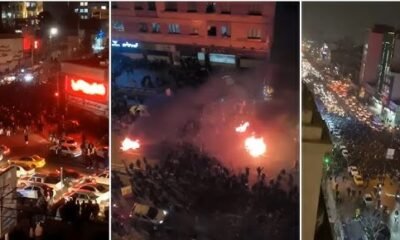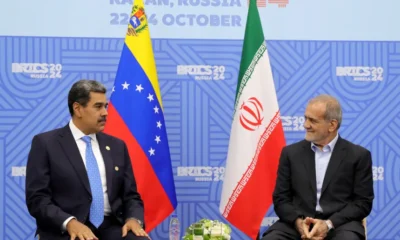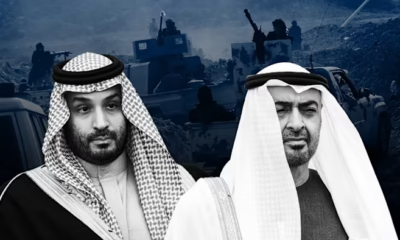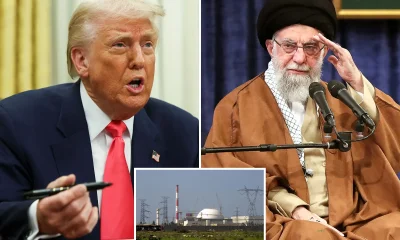Middle East
WHO Chief Trapped During Israeli Strikes on Yemen’s Sanaa Airport

Israeli airstrikes on Houthi targets in Yemen kill six, injure dozens as WHO chief negotiates UN staff release during the attack.
Israeli airstrikes targeting Houthi-controlled areas in Yemen escalated regional tensions on Thursday, killing at least six people and injuring dozens. Among those present during the attack was WHO Director-General Tedros Adhanom Ghebreyesus, who was at Sanaa International Airport to negotiate the release of UN staff detainees.
The Strikes and Their Aftermath
The Israeli Defense Forces (IDF) conducted what they described as “intelligence-based strikes” on military targets in Yemen, including:
- Sanaa International Airport: Strikes damaged the air traffic control tower, departure lounge, and runway.
- Power Stations: The Haziz and Ras Kanatib power stations were hit, affecting civilian infrastructure.
- Ports: Military sites in Al-Hudaydah, Salif, and Ras Kanatib ports on the western coast were targeted.
Houthi-run media reported six fatalities—three at the airport and three in Hodeidah province—and over 40 injuries. Victims included individuals at the airport, where multiple strikes occurred.
UN Response
WHO Chief Tedros Adhanom Ghebreyesus confirmed the strikes disrupted his team’s mission to assess Yemen’s humanitarian situation and negotiate the release of UN detainees. In a statement, UN Secretary-General António Guterres called the strikes “especially alarming,” warning of further regional escalation.
Israel’s Position
Israel’s Prime Minister Benjamin Netanyahu defended the strikes, framing them as part of a broader effort to dismantle Iran’s influence in the region. “We are only just starting with [the Houthis],” Netanyahu said, signaling more actions to come.
The strikes follow a series of Houthi missile launches into Israel, including a recent attack that injured over a dozen civilians. Defense Minister Yoav Gallant warned earlier this week that Israel would “decapitate” Houthi leadership if provocations continued.
The Houthi Response
Houthi leaders condemned the strikes as “barbaric” and linked them to broader regional conflicts, vowing to continue “confrontations with American and Israeli arrogance.” Iran, a key backer of the Houthis, described the airstrikes as a “clear violation of international peace and security.”
Humanitarian Concerns
The presence of WHO and UN staff at the airport during the strikes highlights the fragile state of Yemen’s humanitarian crisis. Sanaa’s airport is a critical hub for humanitarian aid and medical supplies in a country devastated by nearly a decade of civil war. The strikes risk further disrupting already limited aid flows.
Broader Context
The conflict between Israel and the Houthis, an Iranian-backed group, has intensified since the start of the Gaza war in October 2023. The Houthis have launched multiple missile and drone attacks on Israel, while Israel has retaliated with airstrikes in Yemen.
This escalation underscores the broader proxy dynamics in the region, with Iran’s support for groups like the Houthis increasingly drawing Israel into direct conflict beyond its immediate borders.
Conclusion
The Israeli strikes on Yemen, conducted as part of its campaign against Iranian-backed militias, mark a dangerous escalation in the region’s interconnected conflicts. With humanitarian operations and civilian infrastructure caught in the crossfire, the risks of further destabilization loom large.
As the situation develops, the international community will face growing pressure to mediate and prevent broader regional fallout, especially as Yemen remains one of the world’s most fragile states.
Middle East
Damascus Pushes Kurds Out, Unity Pledge Tested

Syria’s fragile post-war transition hit a dangerous flashpoint this weekend after the Syrian army announced it had cleared Sheikh Maksoud, the last Kurdish-held district in Aleppo — a claim immediately rejected by Kurdish forces, who insist they are still resisting.
If confirmed, the takeover would mark the end of Kurdish territorial control inside Syria’s second-largest city, closing a chapter that began in 2011 when Kurdish fighters carved out enclaves amid the collapse of central authority. It would also deepen one of the most sensitive fractures facing President Ahmed al-Sharaa’s new government: how to unify a country still divided by arms, identity and mistrust.
The fighting erupted after a U.S.-backed ceasefire earlier this week failed to resolve the standoff. Under the deal, Kurdish forces were expected to withdraw from Sheikh Maksoud. They refused, citing fears over security and political marginalization under an Islamist-led government dominated by former rebel factions. Damascus responded by announcing a ground operation to expel them by force.
By Saturday morning, the Syrian army said it had combed the district, claiming only small pockets of Kurdish fighters remained in hiding. Kurdish forces countered that the area had not fallen and said their units were holding positions. Reuters reporters in Aleppo reported no active clashes, underscoring the uncertainty surrounding control on the ground.
Beyond the tactical dispute lies a strategic warning. Aleppo has become the testing ground for al-Sharaa’s promise to reunify Syria after 14 years of war. Kurdish forces still control vast swathes of northeastern Syria, where they operate a semi-autonomous administration backed for years by the United States. Talks on integrating those forces into the new Syrian state have stalled, and Aleppo’s violence may harden positions on both sides.
The humanitarian cost is already steep. At least nine civilians have been killed since fighting began Tuesday, and more than 140,000 people have fled their homes, according to local estimates.
U.S. envoy Tom Barrack said he met Jordanian officials to reinforce the ceasefire and push for a “peaceful withdrawal” of Kurdish forces from Aleppo — language that suggests Washington is wary of further escalation but short on leverage.
Whether Sheikh Maksoud has truly fallen or not, the message is clear: Syria’s war may have ended on paper, but the battle over who controls the state — and on whose terms — is far from over.
Middle East
Iran Shuts Down Internet as Deadly Crackdown Fails to Stop Nationwide Protests

BLACKOUT & BLOOD — Iran Pulls the Plug as Protesters Defy Khamenei.
Iran’s government has imposed a nationwide internet shutdown as protests continue to spread despite a violent crackdown that rights groups say has killed dozens, exposing deep fractures inside the Islamic Republic and growing fear at the top of the regime.
Demonstrations erupted again Thursday in Tehran and multiple provincial cities, even as security forces intensified their response. Videos posted before the blackout showed shops shuttered in Tehran’s historic bazaar, a powerful signal of unrest in a country already reeling from soaring inflation and a collapsing currency.
What began as protests over economic hardship has now morphed into a direct political challenge. Crowds in Tehran, Mashhad, Isfahan and Kermanshah were heard chanting slogans against Supreme Leader Ayatollah Ali Khamenei — a red line rarely crossed in the Islamic Republic.
By early evening, monitoring group NetBlocks confirmed that Iran had cut off internet access nationwide, a tactic long used by authorities to isolate protesters, slow mobilization and prevent images of violence from reaching the outside world.
The crackdown has been brutal. Amnesty International said security forces have fired live ammunition, metal pellets and tear gas at largely peaceful demonstrators, while beating and arbitrarily arresting hundreds. The Hengaw Human Rights Organization reported at least 42 people killed so far, including six children. Families of victims, Amnesty said, have been threatened into silence, with officials warning of secret burials if they refuse to cooperate.
Inside the government, the response has been fractured. President Masoud Pezeshkian has struck a conciliatory tone, urging dialogue, while hard-liners have vowed zero tolerance. Iran’s judiciary chief warned this week there would be “no leniency” for anyone deemed to be aiding the regime’s enemies.
The unrest is unfolding under growing international pressure. U.S. President Donald Trump has repeatedly warned Tehran that further killings could trigger American intervention — a threat that Iranian leaders are taking seriously after Washington’s recent capture of Venezuela’s Nicolás Maduro.
For now, neither side is backing down. The streets remain tense, the internet is dark, and Iran’s leadership faces a dangerous dilemma: escalate the violence and risk foreign intervention, or ease repression and risk losing control.
Analysis
How Riyadh and Abu Dhabi’s Quiet War Is Redrawing the Region
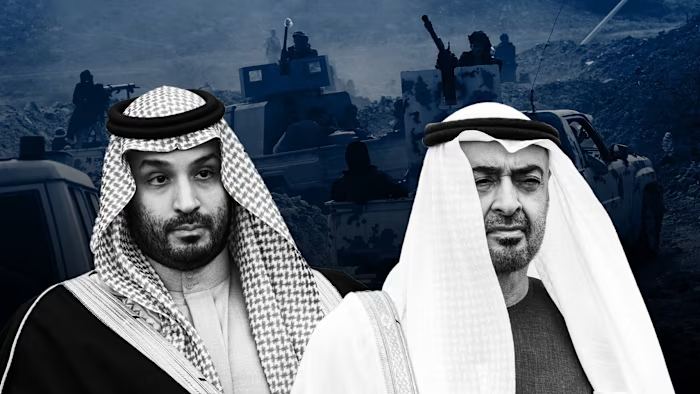
Saudi Arabia–UAE Rift Signals a Deeper Power Struggle Reshaping the Middle East.
Saudi Arabia’s unusually blunt accusation that the United Arab Emirates is undermining its national security marks a turning point in one of the Middle East’s most consequential alliances. What was once a tightly coordinated partnership is now openly strained, exposing a deeper struggle over power, influence and regional order that extends far beyond a single dispute.
At the center of Saudi anxiety is geography. Yemen and Sudan sit uncomfortably close to the kingdom’s borders and maritime lifelines, and Riyadh views instability in either as an existential threat. The UAE, by contrast, approaches both theaters through a different lens: maritime security, trade routes and influence across the Red Sea and the Horn of Africa. That divergence has transformed former coordination into competition.
The immediate trigger was Yemen. When the UAE-backed Southern Transitional Council seized large parts of southern Yemen late last year, expelling Saudi-aligned forces, Riyadh interpreted the move not as counterterrorism, but as a direct challenge to its primacy on its southern flank. Saudi airstrikes on a UAE-linked shipment, and public calls for Emirati withdrawal, signaled that the kingdom was prepared to enforce red lines it once assumed were shared.
Sudan compounds the tension. Saudi Arabia fears that prolonged state collapse across the Red Sea could destabilize its western coast and shipping routes. Emirati engagement there, framed by Abu Dhabi as pragmatic influence and conflict management, is viewed in Riyadh as reckless entanglement with non-state actors — a charge Saudi Arabia once reserved for Iran. The irony is striking: as Tehran’s regional influence wanes, Gulf rivals are now directing similar accusations at one another.
This rift reflects a broader structural reality. Saudi Arabia sees itself as the indispensable pillar of Arab and Muslim leadership, a role it expects smaller Gulf states to acknowledge. The UAE, flush with wealth and global ambition, rejects that hierarchy. Over the past decade it has pursued an assertive, independent foreign policy — from Yemen to Libya, Sudan to Syria — and broken taboos by normalizing ties with Israel ahead of a Palestinian state. To Abu Dhabi, autonomy is survival; to Riyadh, it looks like overreach.
Yet neither side is likely to push the confrontation too far. Both sit astride critical energy chokepoints, anchor global oil markets and rely heavily on U.S. security guarantees. A serious rupture would unsettle investors, roil energy prices and complicate relations with Washington at a moment when both capitals are competing for American favor.
The more likely outcome is a colder, more transactional relationship: sharper economic competition, proxy maneuvering in fragile states, and rival narratives pitched to the White House. The Saudi–UAE alliance is not collapsing — but it is being renegotiated.
What has emerged is a new Gulf reality: unity is no longer assumed, leadership is contested, and stability itself has become the ultimate currency.
Middle East
Saudi Arabia Warns UAE Over Yemen, Alliance Cracks in Public

Saudi Arabia Accuses UAE of Dangerous Yemen Escalation as Gulf Rift Spills Into Open Conflict.
A rare and dramatic public rupture has erupted between Saudi Arabia and the United Arab Emirates, as Riyadh accused its closest Gulf ally of “highly dangerous” actions in Yemen, escalating one of the region’s most sensitive fault lines.
Saudi Arabia confirmed it carried out limited airstrikes on Yemen’s Mukalla port after alleging that two UAE-linked ships delivered weapons and combat vehicles to separatist forces. In an unusually sharp statement, the Saudi Foreign Ministry said the UAE’s actions posed a direct threat to Saudi national security, warning that such threats are a “red line.”
The accusation came moments after Yemen’s Saudi-backed Presidential Council chief, Rashad Al-Alimi, accused Abu Dhabi of directing forces to rebel against state authority and fueling military escalation through its support for the Southern Transitional Council (STC).
Abu Dhabi swiftly rejected the claims, saying the vehicles were destined for Emirati forces operating in Yemen and had been coordinated with the Saudi-led coalition. The UAE condemned what it called attempts to drag it into internal Yemeni tensions and denied pressuring any force to threaten Saudi borders.
The dispute follows a major UAE-backed STC offensive earlier this month that seized control of key provinces, including parts of oil-rich Hadramout, reviving calls for an independent southern Yemen and enraging Saudi-backed factions. In response, Saudi-aligned groups demanded all Emirati forces leave Yemen within 24 hours and scrapped a defense pact with Abu Dhabi.
The fallout exposes a widening strategic rift between two Gulf powers once united in Yemen, Qatar’s blockade, and regional power projection. The United States urged restraint, with Secretary of State Marco Rubio calling for diplomacy to prevent further destabilization.
After more than a decade of war, Yemen remains shattered, and the Saudi-UAE confrontation now risks splintering the anti-Houthi camp, reshaping the balance of power in one of the world’s most volatile theaters.
Middle East
Turkey’s Syria Radar Plan Triggers Israeli Red Lines

Turkey is attempting to deploy radar systems inside Syrian territory, a move that Western intelligence sources warn could sharply alter the regional military balance and directly constrain Israel’s operational reach across the Middle East.
According to two Western intelligence officials cited on Thursday, Ankara has in recent weeks sought to position advanced radar assets on Syrian soil, amid an intensifying standoff between Israel and Turkey over Ankara’s expanding footprint in post-Assad Syria. The implications are immediate and strategic. Radar coverage inside Syria would significantly limit the Israeli Air Force’s freedom of action over Syrian airspace—space Israel has relied on for years to strike Iranian-linked targets across the region.
Israeli planners are particularly concerned that Turkish-operated radar systems could detect and track Israeli aircraft transiting Syrian skies, complicating both intelligence missions and airstrikes. More critically, such deployments would undermine Israel’s ability to reach Iran, as Syrian airspace has served as a key corridor for long-range operations.
The issue cuts deeper than routine military maneuvering. Since the collapse of Bashar al-Assad’s regime last year, Syria has become a contested vacuum, with regional powers racing to secure influence, infrastructure, and strategic depth. Turkey’s efforts to embed radar and potentially air assets in Syria signal a bid to institutionalize its military presence—something Israel views as a direct challenge.
Israeli concerns are not theoretical. Shortly after Assad’s fall, Israel carried out a series of strikes on Syrian military installations, including key Syrian Air Force bases such as the T-4 airbase. Those strikes, Israeli officials later confirmed, were aimed at preventing Turkey from converting former Syrian facilities into permanent Turkish bases capable of hosting drones, aircraft, or surveillance systems.
At the time, an Israeli security official described the prospect of a Turkish military base in Syria as a “potential threat,” warning that it would amount to a direct infringement on Israel’s aerial freedom of action. “If a Turkish air base is established, it would entail a violation of Israel’s freedom of action in Syria,” the official said, adding that the strikes were intended as a clear deterrent message.
What is now unfolding appears to validate those concerns. Radar systems, unlike visible troop deployments, quietly reshape battlespace control. Their presence would not only affect Israeli operations but could also feed real-time airspace data into broader Turkish and allied command structures, effectively turning parts of Syria into a monitored zone hostile to Israeli maneuverability.
The confrontation reflects a wider regional shift. With Iran entrenched, Israel entrenched, and Turkey seeking to translate battlefield presence into long-term leverage, Syria is no longer just a fractured state—it is becoming a strategic chessboard for air superiority and early-warning dominance.
For Israel, the message is clear: radar deployment is not a technical detail but a red line. And for Turkey, the push into Syria’s skies signals ambitions that go well beyond counterterrorism or border security.
As both sides test limits, the struggle over Syrian airspace risks becoming one of the most consequential—and least visible—fronts in the region’s evolving power struggle.
Middle East
Jordan Strikes Drug, Arms Smugglers in Syria Border Region

Jordan’s military has carried out targeted strikes against drug and weapons smuggling networks operating along its northern border with Syria, escalating a campaign that reflects growing regional impatience with the narcotics trade that flourished during Syria’s long war.
According to Jordan’s state news agency, Petra, the strikes on Wednesday hit sites described as “launch points” used by trafficking groups to move arms and drugs into Jordanian territory.
The military said the operation neutralized several traffickers and destroyed factories and workshops linked to organized smuggling networks. The attacks were conducted on the basis of what Petra described as “precise intelligence” and in coordination with regional partners, though no countries were named.
Jordan’s armed forces issued a blunt warning alongside the announcement, saying they would continue to confront threats “with force at the appropriate time and place,” signaling that the operation was not an isolated action but part of a sustained security doctrine along the Syrian frontier.
On the Syrian side, state broadcaster Al-Ikhbariah reported that Jordanian air strikes hit locations in the southern and eastern countryside of Suwayda province, a sparsely governed border region long associated with smuggling routes.
A resident of the area told AFP that the bombardment was “extremely intense,” targeting farms and corridors used to move illicit goods. The Syrian Observatory for Human Rights said jets and helicopters were involved and that damage was visible at an abandoned military barracks once used by the former Assad regime.
There were no immediate reports of casualties, and authorities in Damascus offered no official response.
Independent Syrian outlet Zaman Al Wasl reported that at least one farm believed to be used as a drug storage site was struck. The outlet noted that Jordan has carried out similar operations in the past, underscoring Amman’s growing willingness to act unilaterally when cross-border trafficking is perceived as a direct national security threat.
At the center of the conflict is captagon, an addictive amphetamine-type stimulant that became synonymous with Syria’s war economy. Before the removal of President Bashar al-Assad in December 2024, captagon production had evolved into the regime’s most lucrative export, generating billions of dollars for Assad, his inner circle, and allied militias, according to analysts.
Although Damascus consistently denied involvement, the drug flooded markets across the Middle East, particularly in Gulf states, prompting record seizures and diplomatic pressure on Syria and Lebanon.
Jordan, positioned directly along key trafficking routes, has increasingly framed the drug trade as a form of asymmetric warfare—one that fuels criminal networks, destabilizes border communities, and undermines state authority. The latest strikes suggest that, even after Assad’s fall, Amman sees little evidence that the smuggling infrastructure has disappeared.
Instead, Jordan’s message appears clear: as long as trafficking networks survive in Syria’s borderlands, the battle against captagon and arms smuggling will not stop at the frontier.
Comment
Iraq Blinks, Militias Advance: Iran’s Axis Was Never Broken

Iran-Backed Militias Tighten Grip on Iraq, Underscoring Tehran’s Enduring Regional Strategy.
When Iraq’s government announced this week that it would freeze assets linked to Lebanese Hezbollah and Yemen’s Houthi movement, the decision was initially framed as a quiet but meaningful assertion of sovereignty. Baghdad, the narrative went, was finally drawing a line between the state and Iran’s regional web of militias.
The illusion lasted only hours. The prime minister’s media office abruptly reversed the move, blaming an unspecified “error.” The episode revealed not Iraqi resolve, but its limits.
The rapid climbdown offered a clear reminder that Iran-backed militias remain deeply embedded in Iraq’s political system—and retain the leverage to block any step that threatens their interests or those of Tehran. This is no longer just an internal Iraqi concern. With Syria weakened after two years of war and Israeli strikes, Iraq has become a central pillar in Iran’s effort to preserve and rebuild its regional axis.
Israeli security planners have long warned that militias aligned with Iran possess missile and drone capabilities positioned in Iraq’s vast western deserts. From there, Israel’s northern regions are less than 400 kilometers away.
In the event of renewed confrontation between Israel and Iran, those areas could serve as a forward launch zone. While Iraqi militias largely stayed on the sidelines after limited action in late 2023, there is little reason to assume restraint would hold in a future escalation.
Contrary to the perception that Iran’s proxy network has been decisively weakened, recent political developments in Iraq suggest the opposite. In November’s parliamentary elections, parties tied to Shi’ite militias made significant gains.
Asaib Ahl al-Haq’s Sadiqoun bloc secured 27 seats; the Badr Organization won 18; and Huquq, linked to Kataib Hezbollah, took six. Together, these factions form the backbone of the Coordination Framework, now the dominant force in parliament.
Prime Minister Mohammed Shia al-Sudani, whose bloc lacks a governing majority, depends on this framework to remain in power. Its most influential figure, former prime minister Nouri al-Maliki, has worked systematically to shield militia-linked actors by embedding them within formal political institutions.
The result is a hybrid system in which armed groups convert battlefield influence into legislative authority.
The consequences are structural. Iraq’s state functions, but only within boundaries set by militia power. When critical interests are at stake—sanctions, regional alignment, or Iran’s proxies—the formal government yields.
As one Arab Weekly analysis put it, Iraq now operates as a framework through which powerful political and militia networks rule.
For Israel, the lesson is sobering. The belief that Iran’s regional project has collapsed is premature. It has been damaged, not dismantled. Iraq’s trajectory shows that Tehran’s model—combining elections, paramilitary force, and strategic patience—remains intact, and increasingly effective.
Middle East
Trump Vows Retaliation After US Soldiers Killed in Syria

Trump’s Red Line in Syria: Retaliation, Palmyra, and the Fatal Cost of Reintegrating Extremists.
President Donald Trump’s vow of “very serious retaliation” following the killing of two U.S. Army soldiers and an interpreter in Syria marks more than a response to a single ISIS attack. It signals the re-emergence of a hard red line in American counterterrorism policy—one shaped not only by battlefield violence, but by the dangerous political compromises now defining post-war Syria.
The attack occurred in Palmyra, a city that has become a symbol of both ISIS’s brutality and Syria’s unresolved security collapse. According to U.S. officials, American forces conducting counter-terrorism operations were ambushed by a lone Islamic State gunman. Three additional U.S. personnel were wounded. The attacker was killed, but the damage—strategic and political—was already done.
Trump’s response was direct and characteristically blunt. By framing the incident as an ISIS attack in “a very dangerous part of Syria not fully controlled,” the president implicitly rejected any narrative that Syria’s security environment has stabilized. His warning of retaliation, deliberately left undefined, restores uncertainty as a weapon—one designed to deter not just ISIS remnants, but the permissive environments that allow them to operate.
That environment is inseparable from Syria’s current governing gamble. Palmyra now sits outside the effective control of President Ahmed al-Sharaa, who only months ago met Trump at the White House and secured additional sanctions relief by promising cooperation against ISIS. Yet the reality on the ground tells a far more troubling story. Intelligence and regional reporting indicate that former ISIS operatives have been quietly reintegrated into local security structures under informal agreements designed to reduce insurgent pressure and fill manpower shortages.
The Palmyra attack exposes the fatal flaw in that strategy. When yesterday’s extremists become today’s guards, loyalty becomes transactional and security becomes fragile. The idea that former ISIS commanders can be neutralized through accommodation has repeatedly failed across the Middle East—from Iraq to Libya—and Syria is now paying the price.
This is not merely a Syrian problem. For Washington, the incident cuts to the core of U.S. force protection and alliance credibility. The United States maintains roughly 1,000 troops in Syria, primarily working alongside Kurdish-led Syrian Democratic Forces to prevent an ISIS resurgence. These forces operate in a landscape riddled with overlapping militias, shifting allegiances, and security services built on expediency rather than accountability.
Trump’s warning therefore carries broader implications. Retaliation may target ISIS cells, but it also serves as a signal to Damascus and its partners that cosmetic stabilization will not shield them from consequences if American personnel are endangered. Sanctions relief, normalization, and diplomatic patience are conditional—not entitlements.
The deeper lesson of Palmyra is that ISIS was never defeated as an idea, only displaced as a governing structure. Its networks persist, adapt, and exploit every governance vacuum. Reintegration without justice does not neutralize extremism; it embeds it. When states outsource security to former enemies without transparent vetting or accountability, they trade short-term calm for long-term vulnerability.
Trump’s posture reflects a return to a doctrine where ambiguity favors deterrence, and where U.S. casualties reset the strategic clock. Syria’s leaders now face a stark choice: dismantle the shadow arrangements that blur the line between state authority and extremist accommodation, or accept that American retaliation will arrive without warning and without apology.
Palmyra, once a monument to history, has become a warning. Stability built on compromised foundations does not hold. And in Trump’s Syria, the cost of pretending otherwise is rising fast.
-

 Analysis10 months ago
Analysis10 months agoSaudi Arabia’s Billion-Dollar Bid for Eritrea’s Assab Port
-

 Opinion17 years ago
Opinion17 years agoSomaliland Needs a Paradigm Change: Now or Never!
-

 Interagency Assessment4 weeks ago
Interagency Assessment4 weeks agoTOP SECRET SHIFT: U.S. MILITARY ORDERED INTO SOMALILAND BY LAW
-

 Somaliland3 months ago
Somaliland3 months agoSomaliland Recognition: US, UK, Israel, and Gulf Bloc Poised for Historic Shift
-

 EDITORIAL1 year ago
EDITORIAL1 year agoDr. Edna Adan Champions the Evolving Partnership Between Somaliland and Ethiopia
-

 ASSESSMENTS10 months ago
ASSESSMENTS10 months agoOperation Geel Exposes the Truth: International Community’s Reluctance to Embrace Somaliland as a Strategic Ally
-

 Somaliland12 months ago
Somaliland12 months agoSomaliland and UAE Elevate Ties to Comprehensive Strategic Partnership
-
Top stories2 years ago
Ireland, Norway and Spain to recognize Palestinian state








